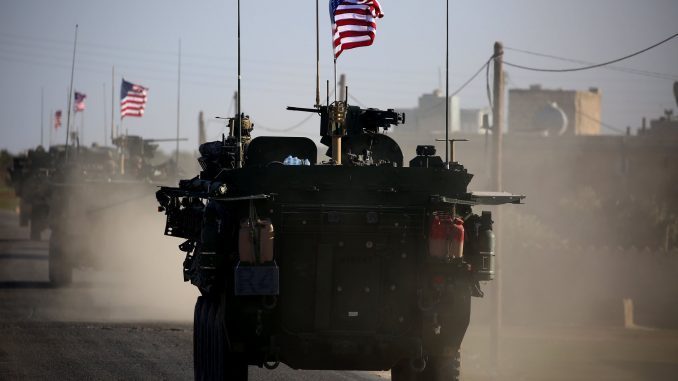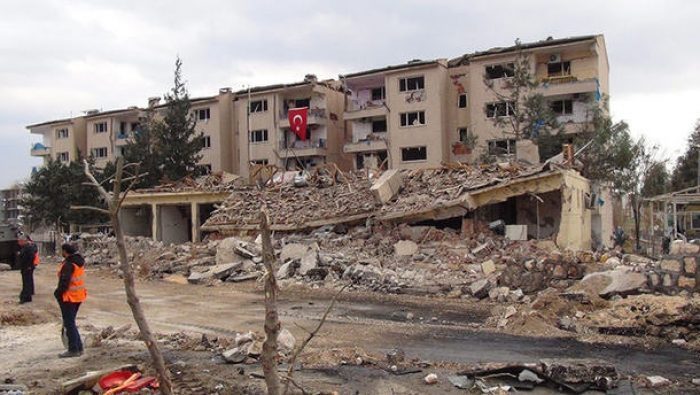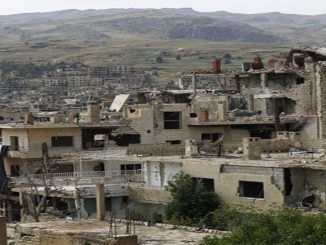
A few hundred US marines with heavy artillery have been deployed to Syria in preparation for battle in Raqqa, Islamic state’s stronghold in Syria, a move that blows up years of US’ caution in Syria and opens the door for countless speculations about future consequences.
The Syrian Democratic Forces (SDF) alliance, which is dominated by the Kurdish YPG militia, is supported by the US as the latter uses them in its war against ISIS.
Air strikes carried out by the US-led coalition and a long fight by the SDF forces ended in recapturing Manbij from the control of the Islamic State (ISIS) group last year.
The SDF, backed by US coalition, launched also a campaign with the ultimate aim of capturing Raqqa in November and succeeded in encircling the city. Recently, they launched an assault on Deir Ezzor province to cut the road to Raqqa and surrounding ISIS effectively and were able to achieve this goal after fierce clashes.
Turkey sees the YPG as an extension of Kurdish PKK militants, who have waged a three-decade insurgency in southeastern Turkey, and sought therefore to sideline the Kurdish role in Raqqa operations but failed until now to achieve this goal.
However, with the US sending its troops to take part in Raqqa’s operations, it seems that Turkey has been fully sidelined and that the battle will be leaning essentially on the Kurdish militias.
Deployment of new troops
A few hundred marines with heavy artillery have been deployed to Syria in preparation for the fight to oust Islamic State from its self-declared headquarters of Raqqa, a senior US official said last week.
The deployment is temporary but is a sign Donald Trump’s White House is leaning toward giving the Pentagon greater flexibility in making routine combat decisions in the fight against Isis.
Military commanders frustrated by what they considered micromanagement under the previous administration have argued for greater freedom to make daily decisions on how best to fight the enemy.
The marines moving into Syria are positioning howitzers to be ready to help local Syrian forces, said the official, who was not authorized to discuss the deployment publicly.
In addition, the US is preparing to send hundreds of troops to Kuwait to be ready to fight Isis there if needed, the official said. The number would be fewer than 1,000, the official said.
The latest troop movements come on the heels of the recent temporary deployment of dozens of army forces to the outskirts of Manbij, Syria, in what the Pentagon called a “reassure and deter” mission. Flying American flags and moving in large, heavily armored vehicles, the troops were there to keep a lid on tensions in the area, the Pentagon said.
It appeared the forces were largely there to ensure Turkish fighters and Syrian opposition groups focused on battling ISIS rather than each other.
What consequences may follow this move?
Analysts say that the simplistic idea, promulgated by Trump, that Isis and its warped jihadi ideology can be annihilated by force is foolish and naive. More dangerous still is Trump’s apparent belief that the US can focus solely on Isis while ignoring bigger questions about Syria’s future. In the space of a few chaotic weeks, Trump has overturned eight years of Barack Obama’s cautious policy towards Syria. Unlike Iraq, where Washington is co-operating with a mostly friendly government, the US faces the hostility of Bashar al-Assad’s regime, whose removal it still officially seeks.
The US marines and special operations forces, totaling nearly 1,000, are vulnerable to attack by larger groups more accustomed to the terrain. The dire consequences, should a US soldier be taken hostage by Isis, can only be imagined. At the same time, ostensible US allies, such as Turkey, cannot be relied upon, while Russia and Iran, Assad’s main backers, have no interest in ceding ground and influence.
The key, longer-term struggle is not over the fate of Isis, but the political control and territorial integrity of northern Syria and, by extension, Iraq. All the key players have differing interests. Assad wants his country back, whole and entire. Turkey wants a border “safe zone” under its control, principally to curb autonomy aspirations among US-allied Syrian Kurds. For their part, the Kurds want to be free of Damascus’s yoke and some would like to join forces with the self-governing Kurdish regional administration in northern Iraq, a prospect Ankara views as an existential threat, given its own large, disaffected Kurdish population.
Whatever Trump thinks about a new era in relations with Moscow, Russia, the real military power in the air and on the ground in Syria, will not help. It wants to minimize American leverage, in line with Vladimir Putin’s bid to project Moscow’s influence across the Middle East and Afghanistan.
Russia, Turkey, and jumping in the quagmire
This objective underlay last week’s summit between Putin and Recep Tayyip Erdoğan, Turkey’s president, at which the leaders buried old disagreements over Syria and pledged to work together to defeat terrorism. In Erdoğan’s view, this means the US-backed Syrian Kurds as much, if not more, than Isis. Erdoğan said Russia had agreed to lift all remaining sanctions imposed after Turkey shot down a Russian combat plane over the Syrian border in 2015. On the diplomatic front, meanwhile, Turkey is backing the Russia-Iran “peace plan” for Syria, which sidelines the US and Europe.
It is easy to forget that Turkey is a Nato member and EU applicant. Openly defying the west and reversing his previous stance, Erdoğan has now, in effect, joined Russia and Iran in supporting Assad. “We are working in full co-operation militarily in Syria. Our chiefs of staff, foreign ministers, and intelligence agencies cooperate intensely,” Erdoğan declared in Moscow.
The unfortunate, but perhaps inevitable, a corollary of this Russian-Turkish detente is Ankara’s repeated threat to further reduce security co-operation with the US unless it ditches the Syrian Kurds (which it has so far refused to do). Direct confrontations are thus possible between US and Turkish troops and their respective rival proxies, the Syrian Democratic Forces and the Syrian Free Army, whom US troops are tasked with keeping apart in the northern town of Manbij.
Trump’s Syrian intervention is “fraught with risk”, Robert Ford, former US ambassador to Damascus, told the Washington Post.
“It is a huge policy change.” The potential for military escalation or “mission creep”, if and when US ground troops get into trouble, is obvious, vast and worrying. Northern Syria is a quagmire. Trump just jumped straight in.



